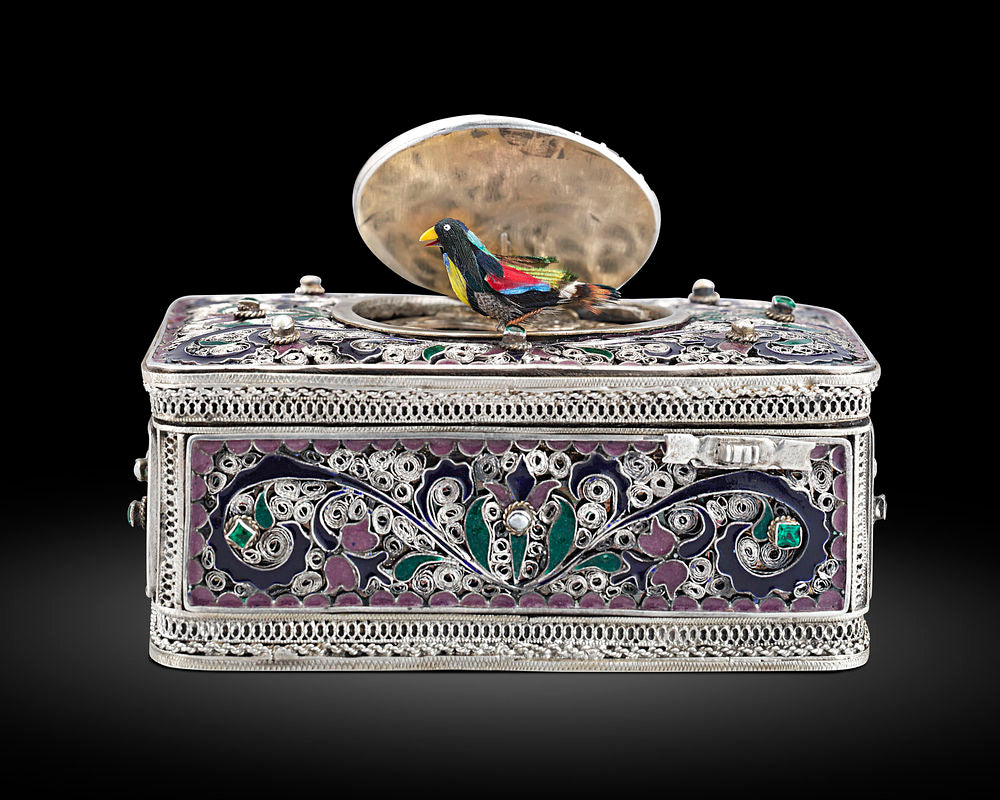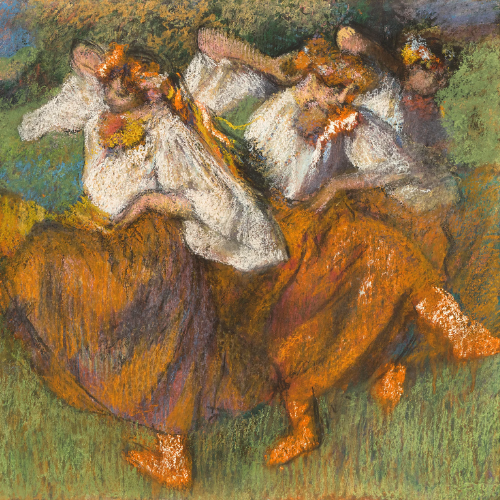Bird Boxes
ASJRA Magazine (Association for the Study of Jewelry and Related Arts), April 2013--
A tabatière à oiseau chanteur (singing bird snuffbox) is a box, usually rectangular-shaped, which houses within it a miniature automaton singing bird concealed below an oval lid and activated by means of an operating lever. Its origins are found in the Swiss city of Geneva and its invention in 1784 is attributed to Pierre Jaquet-Droz.
The French term tabatière has come to be used for any small decorative box resembling a snuffbox in form but not necessarily any longer used to contain snuff.

19th-century Hungarian silver and enamel tabatière, or singing bird box
This object is made up of two separate parts, usually crafted by different makers. The outer casing is a rectangular box variable in size, although with a standard measurement of approximately 100 × 65 × 40 mm, made of base metal, precious metal, tortoiseshell or other materials. It has an oval hole, some 45 x 35 mm in its top, edged normally by a decorative metal bezel.
On the front of the box there is a small slider that when it is pushed to the right, the lid or medallion lifts to a near-vertical position, and a small, mechanical feathered bird pops through a grille and stands upright at the front center of the oval opening. Then it begins to turn from side to side, to flap its wings, move its tail up and down, open and shut its beak and - in some cases - turn its head from side to side, while producing an unbroken stream of birdsong. At the end of the performance the automaton falls back into the box and the lid closes.
All bird box movements have a clockwork motor which must be wound up. This motor is doing two basic jobs: The first one is to operate a small bellows which supplies air, via a wind chest, to a whistle which produces the birdsong and the second task is to rotate a number of cams. One cam controls the note produced by the whistle, a second determines when the note will be produced and for how long, and a third one produces the motion which causes the bird to turn from side to side. In some movements the flapping of the bird's wings and its ability to turn its head are also cam-controlled. In others not.
The final cam determines the point at which the song ends, the bird folds away, the lip drops and the motor stops. The bird's beak movements are always connected to the cam controlling the air supply to the whistle: in this way the sound and beak movements are automatically synchronized.
The whistle consists of a miniature organ pipe containing a close-fitting piston which can be moved up and down to give a range of notes of over an octave.

The hand-feathered automaton bird in a rare 19th-century Continental silver singing bird box.
The winged performer may vary in size but 30 mm from beak to tail is common. The bird itself consists of a brass frame to which two half-body shells are attached, each half-shell having one wing pivoted to its side. To dress a few of them, feathers of South American hummingbirds were utilized in the past for their brilliant red, green and blue iridescent colors, which gave a well feathered bird an almost jewel-like appearance, but nowadays they are not longer available.
The movement is a compact device located between two brass plates. During its over two hundred years of existence there have been used two types of mechanisms, each with its own characteristics: The fusee-driven movement and the going-barrel movement.
Switzerland was where the origins of the singing bird box come and its development during "the Golden age" from 1785-1885. Pierre Jaquet-Droz (b. 1721), is regarded as one of the most celebrated automata maker of all times and is credited the invention of the tabatière or boîte à oiseau chanteur.

Swiss singing bird box, circa 1930
Jacob Frisard is another key name in the history and development of this artifact. Born at Villeret (Switzerland) in 1753, served his horological apprenticeship in La Chaux-de-Fonds. Then, he settled in Geneva around 1784 where he worked for Pierre and Henri-Louis Jaquet-Droz and their associate Jean-Frédéric Leschot. He became a great master of singing bird technology, creating some of the most wonderful pieces sold by the Jaquet-Droz firm and contributing to their fame. His close collaboration with Leschot was to result in some of the most important technical innovations in the field; for instance, the automatic closing of the bird medallion or lid. Around 1800, he set up his own business and sought to show his creations to influential people, including Napoleon Bonaparte and organized an exhibition of his works in Zurich in 1809, but his efforts remained fruitless. In the early years of the 19th century, Frisard embarked on a series of journeys to exhibit his mechanical pieces throughout Europe, he eventually died in 1810 during the return journey to Geneva after a selling trip to Istanbul.
His particular expertise was in designing and cutting the cam sets needed to produce the bird song. He made cams which were arranged in a continuous spiral, so that no break occurred from the beginning of the bird's song to the end. This was a unique feature, never repeated by any other bird box manufacturer. He certainly made many, and possibly all, the cam sets used by the Jaquet-Droz and was also employed by Frères Rochat at the outset of their production. Other important Swiss makers were Frères Rochat and the Bruguier family.
During the second half of the nineteenth century until World War I, Paris was the booming center of automata production worldwide and it is in this historical context that the Maison Bontems flourished. France took leadership in the construction of quality tabatières during the last quarter of the 19th century and early 20th century.
The extensive series of mechanical changes implemented by the reputed French house includes replacing the fusee motor employed by all the Swiss makers until then, by a simple going-barrel, the stack of eight song/air cams by just two and the parallel action bellows by a Vee-form bellows, the bird mechanism was much simplified as well. This basic movement was to become pattern and standard for all succeeding makers up to the present.[5]
Bontems can be regarded as the father of the modern singing bird box, after its simplification of the movement and improvements in the sound. This transformation can be compared to what happened to the pocket watch when the fusee mechanism was substituted by the barrel. A successful house lauded for the realistic quality of their songs, they exhibited in several Universal Expositions and fairs where they were awarded with 38 international medals of gold, silver, vermeil and bronze in Europe, the United States, Asia and Australia. They were suppliers "to her Royal Highness the Queen of England", among others.
A well-adjusted Bontems movement with its bellows in good condition produces clear and pleasant bird-song for about fifteen seconds each performance. It is of simple and sturdy construction and in its day made ownership of a singing bird box possible to a wider public than any of its Swiss predecessors, even though continued to be an article de luxe reserved for the thriving bourgeoisie and the upper classes.
The other prestigious Parisian maison is E. Flajoulot, which started to fabricate singing bird tabatières for the first time around 1890 until the 1950s. Lastly, Juvenia operated in France from around 1893, they produced several models being the most popular of its range a sarcophagus-form wooden case with hand painted country scenes and people dressed in the 18th century manner.
The intervention of the Parisian automata-makers in the history of this curiosity item no doubt resulted in a revolution. Many traditional features of the Swiss singing bird boxes were eliminated: The fusee in favor of a going-barrel, the lid slow-close wheel train, the longer song and in simplifying the bird's internal mechanism, the loss of head movement only took the automaton bird back to its origins. The work of Bontems, his contemporaries and successors preserve it for posterity in circumstances where, without them, it might have disappeared[10] victim of an unstoppable and progressive industrialization.
Great Britain
The one and only British manufacturer of bird boxes was John Manger and Co., London, whose main activity was watchmaking (maker and importer). John Manger, listed as working in London from 1875-1881 in Brian Loome's Watchmakers and Clockmakers of the World, started to make them in 1878, he retired in 1899. The successor company, John Manger and Sons, London, was in operation during the early 20th century but did not reach the same level of quality as the earliest. They all fitted the Bontems type going-barrel movement.
Germany

A rare silver singing bird box from Germany, circa 1900
Tabatiéres of the Bontems style were produced with the mark of C. K. Lamy of Furtwangen in the Black Forest. In his book Mechanische Singvögel, Peter Schukhnecht traces the history of the firm to its closing in 1927. Little is known of its range, but the few examples seen have been housed in well enamelled silver boxes and have birds with bone beaks. The movement is basically a copy of Bontems.
The company that dominated the twentieth century manufacture of singing bird boxes for more than 50 years with an output exceeding all others put together, was the prolific firm of Karl Griesbaum (1872-1941).
Founded in 1905 also in Triberg, they originally made clock parts and in the early 1920s embarked on the production of singing bird boxes until the firm closed in 1988. During the course of its lifetime the cases were supplied to them in a variety of over thirty different styles, some based on previous models by Rochat, Bruguier, Bontems, etc., while others displayed novelty designs not seen before.
When they closed the contents of the Griesbaum workshops were purchased by Siegfried Wendel who moved the production to Rüdesheim am Rhein (Germany) setting up MMM (Mechanische Musikwerke Manufaktur) GmbH in 1990. In 1993 they resumed the making of singing bird boxes in the tradition of Griesbaum. There are only a few other firms making singing bird boxes today.
The singing bird box is a perfect compendium of art and science that must be studied and understood as a whole, where different arts and crafts came together to produce a unique, timeless objet d'art. When purchasing or appraising, several aspects must be taken into account, basically four; the manufacturer, the condition, the quality of whistle and the case. With regard to the case, its design, workmanship, techniques used in the manufacturing process and decoration (e. g. guilloché enamel, hand painted scenes in the lid...), type of material utilized; precious metals, tortoiseshell, ivory, mother of pearl, etc. As for the bird, a discerning point is the complexity of the melody and quality of sound, its general appearance, type of feathers (for instance, iridescent real hummingbird feathers), the beak; ivory or bone versus metal or plastic, if the minute avis body is well-proportioned and detailed, etc. Another issue is the rarity or singularity of a certain piece, for example if it has an added complication such as two automata instead of one, a musical movement and/or a timepiece, etc., etc. Antique bird boxes come up at auction and are sold by a few companies such as antique dealer M.S. Rau.







